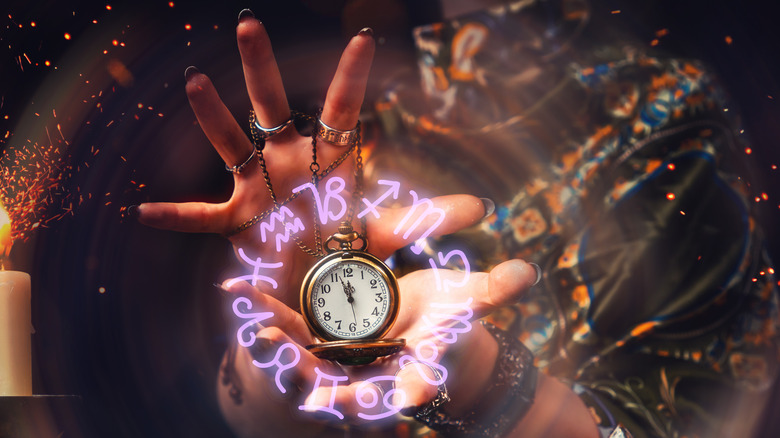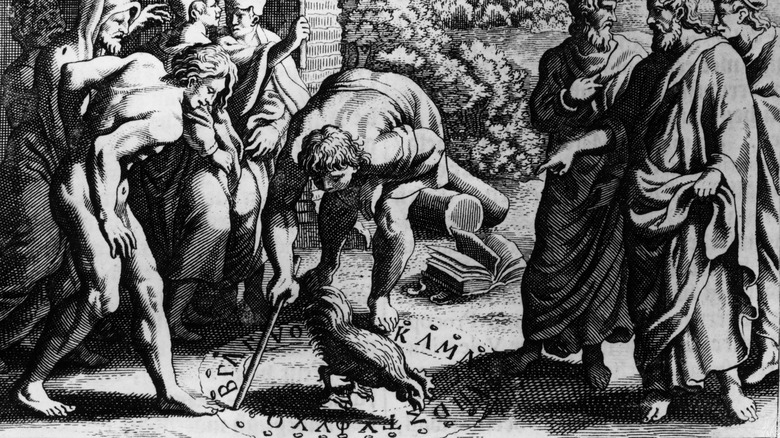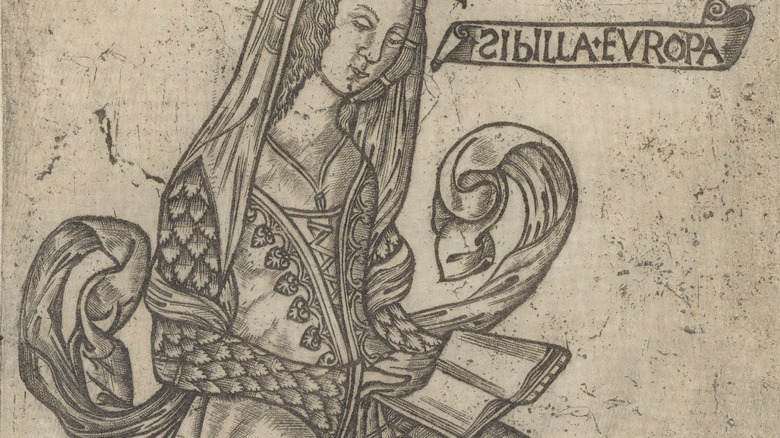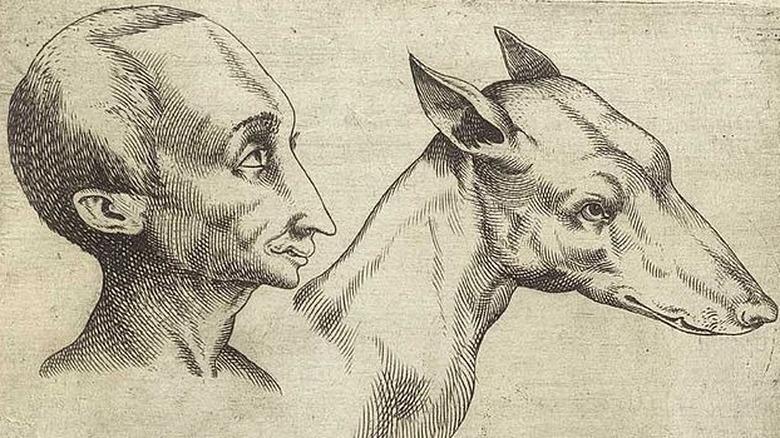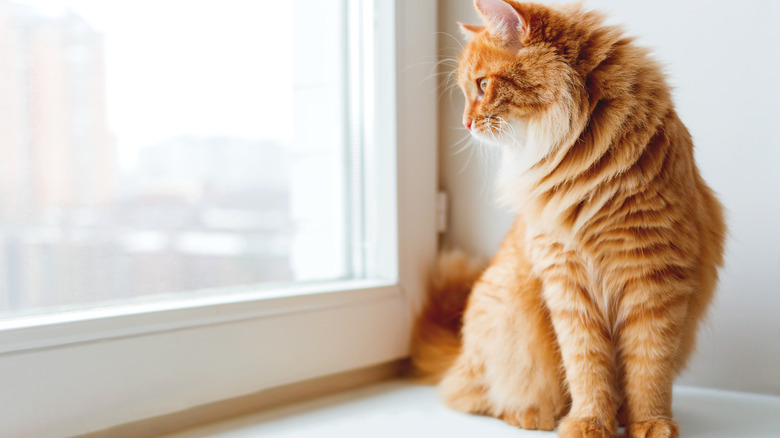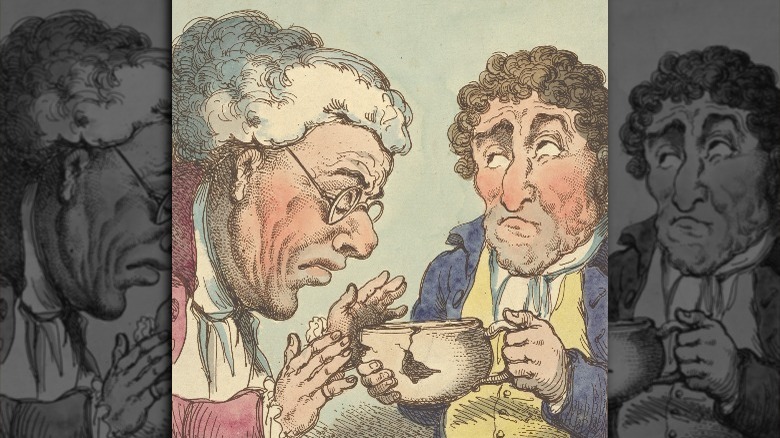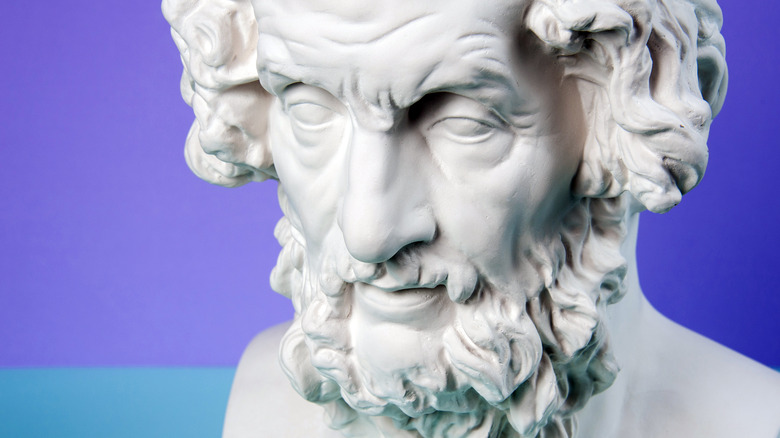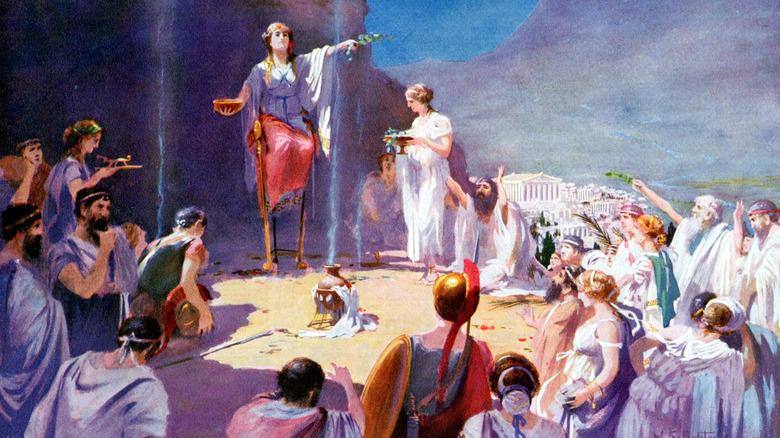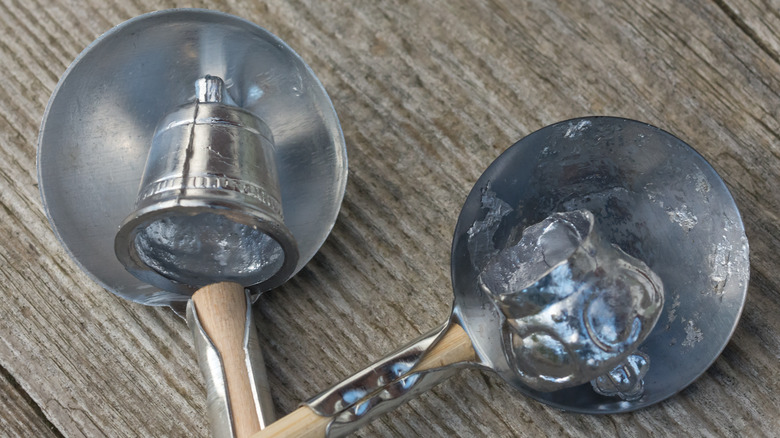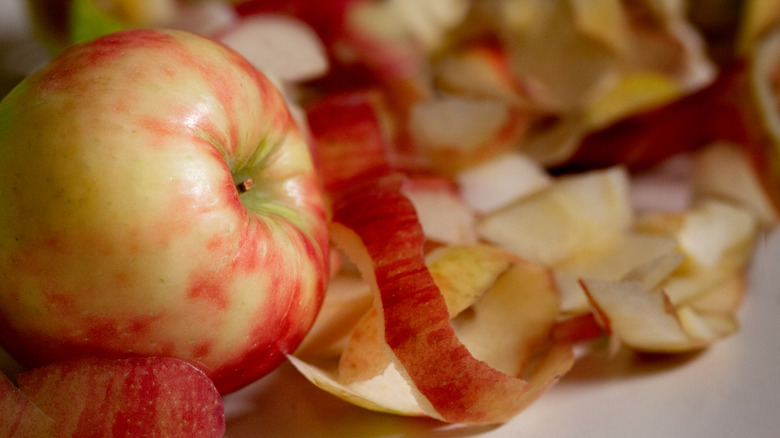The Weirdest Ways People Have Tried To Tell The Future
We differ from our ancestors in many ways. We no longer put "Here be Dragons" on our maps, most of us accept the Earth isn't flat, and we can use things like smartphones and emojis. But that's really all surface stuff — at heart, we're not all that different.
We still feel all the basic human emotions like love and grief, sadness, anger, and happiness. We love and care for our families, whether we're born into them or we choose them, and we have an undeniable desire to know what's coming next in this rocky, oftentimes painful existence we call life.
Almost every person in history had to face daily decisions that seem insurmountable, and the questions that go along with them. Are we doing the right thing? Will this all work out in the end? Is it all going to be ok?
There's no real, honest-to-gosh way to tell what the future holds, but that hasn't stopped people from trying. Sure, a lot of the ways our ancestors have tried to get a glimpse into the future might look weird, but it's worth remembering that they were driven by the same uncertainty, fear, and hope that we still experience today. Discover the weirdest ways people have tried to tell the future.
What does the chicken say?
Quick, who was most responsible for shaping the direction of ancient Roman society, culture, expansion, and policy? An emperor? Wrong! According to the History Collection, the answer is actually the pullarius. That basically means "priest of the sacred chickens."
These holy men kept chickens that came from an island off the coast of Athens, which they then consulted when a massive decision needed to be made. It was pretty straightforward: The chickens would go unfed for a period of time, then be presented with grain. If they ate it, it was an indication that the outcome of whatever endeavor was in question would be ultimately favorable to Rome. If they ignored the grain, it was a sign that the gods had abandoned Rome.
Sounds unlikely? Roman Times says that chickens — and roosters in particular — have been seen as sacred animals for a long time. Rooster deities were worshipped by the ancient Assyrians and Persians, and by the time the Romans came along, they had become basically a divine messenger.
The practice of observing a chicken to get a glimpse into the future is called alectryomancy, and the Etruscans went even further than the Romans. They put their chickens into a circle marked with the alphabet, then scattered grain and observed the patterns the chicken ate in. If all went well, it would spell out hints to the future.
With help from a Christian text
Divination and fortune-telling in medieval Europe was a little dicey, according to the J. Paul Getty Conservation Research Foundation Museum. It didn't really fall in line with the whole Christianity thing, and the church had strong feelings about using pagan traditions. But using medieval texts to try to look into the future was definitely a thing, and it started with Saint Augustine.
The story goes that Saint Augustine became a Christian after hearing a voice that bid him to pick up the Bible and read it, so he did. The first passage he read was, "Not in carousing and drunkenness, not in sexual excess and lust, not in quarreling and jealousy. Rather, put on the Lord Jesus Christ, and make no provision for the desires of the flesh."
Midwest Augustinians says that's when he turned down his new path, and that's also the basis of a lengthy fortune-telling process. Applicants would fast for several days, attend a series of masses, spend a ton of time praying, then, it was time for business.
After asking their question, they'd throw three dice onto an altar. The dice would then be arranged in descending order, and used to find a passage in a chosen Christian text. The idea was that the passage would give clues as to what was to come. Did it work? With a little creative interpretation, anything can "work."
You've got a funny nose. You know that that means.
Physiognomy is the idea that the way a person looks is reflective of their character. It's why we have terms like "stuck up," a reference to the olde-timey belief that people with upturned noses tend to have superiority complexes.
According to the J. Paul Getty Conservation Research Foundation Museum, physiognomy has had a pretty far-reaching impact on culture and the development of racist attitudes. It was also believed that looking at a person's facial features would reveal future behaviors.
It's a shockingly old idea. In 500 BC, Pythagoras was well-known for accepting students based on their appearance, because he thought he could tell exactly how successful they would be by the shape of their faces. Even stranger? It's an idea that's still around today.
In 2015, Asia Society talked to Sang-Jin Rho, a physiognomy scholar who claimed to be able to tell a person's future by the shape of the face. Rho says destiny is directly linked to the face you were born with, and that a skilled face-reader can interpret features to figure out what the future holds. So, what about those who have had plastic surgery? Rho says they can't change the destiny that comes with the face they were born with.
Ever have a gut feeling? There may be more to it.
Ever heard your stomach grumble and think it is trying to say something? That's probably a message along the lines of "I'm hungry," or "I'm full," or "Why the heck did you think that was a good idea?"
In a way, that's kind of telling what's going to happen in the near future, isn't it? Maybe the ancient art of gastromancy isn't so far-fetched after all.
According to the Courier, gastromancy was a practice in ancient Greece and medieval Europe. It was based in the belief that the sounds made by the stomach were actually the voices of the dead, and anyone skilled enough could listen to them and hear prophetic whispers.
In another version, CSOFT International says that interpreters might look at the lines on a full stomach and read the future. It seems to have been taken with varying degrees of seriousness. There are records of the oracle at Delphi using gastromancy, but fast-forward to the 17th century, and it was more of a hilarious after-dinner parlor game.
Even stranger, according to CSOFT International, the idea that voices were heard in stomach sounds ended up evolving into ventriloquism, which is basically a person's ability to manipulate their voice so it sounds like it's coming from somewhere else.
Keep an eye on the cat
It's no secret that animals know way more than mere humans. Still, the case of Oscar the Death-Predicting cat was unique — so unique that it appeared in the New England Journal of Medicine, according to Vice.
Oscar lived at the Steere House, a Rhode Island nursing home. When he made his rounds and selected a patient to curl up next to, their death was inevitable. Over the course of just a few years, he signaled the deaths of more than 50 people.
According to Learn Religions, people have been putting their faith in cats for a long time. Observing a cat's behavior was said to give clues as to what was to come: A cat staring out the window for a long, long time meant rain was on the way, for example, and if one were grooming his fur backwards, that was a sign of snow.
In some areas — particularly in Eastern Europe — the yowl of a cat was said to herald someone's death or dire misfortune, but it's not all bad. In Italy, it's sometimes said that hearing a cat sneeze is sign that good luck is on the way. And let's talk about the black ones. No, they're not always bad luck: some old beliefs say that an all-black cat with a single white hair is actually a sign of good things on the horizon.
When seeing the future involves a trip to the bathroom
Doctors have known for a long time that the condition and intimate details of what comes out of a person's nether regions can give significant clues as to what's happening inside their bodies. That's gross, but it makes sense.
There's also a school of thought that says that what comes out can also be used to predict the future, and it's called scatomancy. The fortune teller, or scatomancer, basically takes a look at a person's poop and attempts to find clues about their future there.
Are there still scatomancers around? Yes, according to the Huffington Post. In the documentary "Journey to Planet Sanity," the filmmakers head to a consultation with a man named S.S. Singh. Singh had his subject start the process by heading into the bathroom and having him do his business, with a reminder not to flush. From there, Singh collected the specimen in a dish, and set about foretelling. After waving about some sage, Signh reached right in there, saying, "You have to get into it. The stronger the aroma, the more accurate the prediction."
The prediction ultimately involved things like accompanying and supporting a friend on a journey, and a promise of continued strength and longevity. Did he really have to smell it to come up with that? According to Singh, yes, yes he did.
What if you only have to go Number One?
Doctor's Review says that in ancient Greece, urine was considered "a divine fluid." Some of what the ancient Greeks did with urine was almost legit, including examining samples for signs — and tastes — of illnesses like diabetes.
But there was more to it for a uromancer. In ancient Rome, taking a good long look, whiff, and taste of a person's urine was the stuff of entertainment. They were different times.
Uromancy involved taking a newly filled chamber pot, giving it a good stir, and interpreting whatever happened in there in order to give the patient an idea of what was waiting for them in the future. Medical professionals could, in some ways, diagnose illness from a person's urine. (Sometimes, they were wildly wrong, but that's another story.) But fortune-telling was even more iffy.
Later, at the turn of the 19th century, "piss prophets" went underground. While mainstream medicine moved on, these "doctors" claimed to see all kinds of things in a patient's urine, and provided their services to those disillusioned by more scientific methods.
But exactly how did reading urine work? Some would "read" the bubbles as the subject was doing their business, and others got poop involved, too. How? Pee on the poop, make bubbles, and see your fortune. Yikes.
The answer is in the books
Everyone's at least heard of "The Iliad" and "The Odyssey," and there's a lot of really weird things actually going on with these two iconic works. The British Museum explains that not much is known about their author, Homer, including whether he actually existed. Regardless, his works were used to get a glimpse into a person's future. The British Library calls it the Homeromanteion, or Homer oracle.
The practice goes back to Roman Egypt, and the earliest evidence of it dates back to the 2nd century BC. (By comparison, Homer's works are usually dated to the 7th or 8th century BC.) Those looking for guidance were told to select a day to consult the oracle, then pray completely and thoroughly, and silently repeat the questions that needed answering. Then, throwing a die three times would give three numbers, which would then correspond to a passage in Homer's works. Whatever the passage was, it was thought to give some kind of look into what the future held in store.
Other texts have been used for variations of this: throwing die — or choosing a number at random — would lead fortune-tellers to answers written in tables. The British Museum holds an ancient scrap of papyrus that contains part of the Oracles of Astrampsychus. It includes numbered questions and answers such as "Am I to recover from my illness?", "Shall I have a baby?", and "Am I to be separated from my wife?" It seems people haven't changed that much after all.
Give me your hands
In 1159, the philosopher John of Salisbury wrote about a weird experience he'd had as a boy. He had been studying with a priest at the time, and he wrote about a "sacrilegious art" in which the priest would put sacred oil on the boys' fingernails, then try to see the future reflected in the sunlight there.
It's actually a form of divination called onychomancy, and Mysterious Britain says Salisbury claimed other students had seen ghostly figures and demons reflected in their nails. Probably not the most promising of futures to admit to, but the future holds what the future holds.
Nails magazine says that the practice goes back to at least ancient Greece, and adds that yes, it's traditionally been a young boy who's used for the nail-reading. At that time, a mix of soot and oil was used to paint the nails, and then the reflections were interpreted to answer questions such as the outcome of upcoming battles.
Later, the practice shifted a bit. Throughout medieval Europe, it was believed a person's nails would give clues about their future — particularly when white spots would appear. One on the nail of the little finger, for example, meant the person was going on a journey, while a spot on the index finger met a reunion with a friend.
Does it matter where the visions come from if they're right?
The Oracle at Delphi is one of the most famous fortune tellers in the world, and according to Rebus, the Pythia of Apollo's temple became the most sought-after soothsayer among all the oracles of ancient Greece. In order to consult her, applicants would have to get on a waiting list — which could take months — then, when it was time, offer up a sacrificial goat and take a purifying bath. It was only then that the Pythia would answer whatever questions they had about the future. At the time, the predictions were believed to be visions sent from Apollo and left for the recipient to interpret. Now, historians say that's not precisely the case.
Apollo, says History Answers, was thought to send his wisdom to his earthly representative with the help of vapors that drifted up though a fissure in her chambers. And here's the odd thing — even though historians know where the temple is, finding out just what the vapors were has been difficult.
The running theory is that they were some sort of combination of methane, ethane, and ethylene gases, leaking up into the chambers and getting very, very concentrated. Some throw a little carbon dioxide in there (via LiveScience), but either way, even the ancient Greeks acknowledged that the oracle tranced out by huffing some noxious fumes. Who better to ask about the future?
A bit of deadly fun?
Molybdomancy is the practice of melting a substance, then pouring it into water to harden it into a shape that's then used to predict the future. The huge problem comes in with the fact it's traditionally done with lead.
In ye olde times, it wasn't really clear just how dangerous lead was. The Australian Department of Agriculture, Water, and the Environment confirms that yes, molten lead releases toxic fumes that can be inhaled by anyone nearby, and that makes it even odder that a specific sort of molybdomancy — bleigiessen — remains popular in German-speaking countries to this day.
According to the German Way, bleigiessen is a New Year's tradition that dates back to the Celtic and Roman eras, and is still practiced in Finland, Turkey, and Germany. Lead — or, alternately candle wax or tin — is melted, then dropped into a bowl. If it forms a ball, that means the new year will be filled with luck. A frog means some lottery winnings are on the way, and a chalice means a general sort of happiness.
Oddly, none of the shapes are linked to lead poisoning, which seems like the most likely outcome. Use of lead in bleigiessen kits was only banned in 2018.
An apple a day
Bobbing for apples is one of those traditional Halloween activities that everyone hears about, but nobody seems to do. It's a tradition that was once linked to gaining insight into the future.
Fruit historian Joan Morgan told NPR that it was once wildly popular for girls to make particular marks on the apples destined to be bobbed for — and when a boy surfaced with one of the apples, it was said to hint at a future romance.
Apples have long been linked to ideas of fertility and rebirth: Apple blossoms in the spring signaled the end of the winter months, and the autumn apples themselves were an invaluable part of the harvest. That, Morgan says, is what led to a belief in their ability to give hints at a person's future love life.
These old European beliefs were carried to the New World, too. Girls who peeled an apple in a single strip of skin would throw that peel over their shoulder, and hope that it would land in the shape of a young man's first initial. Learn Religions says they were also used to help girls make a choice between suitors: Take the seeds of an apple, assign them names of potential matches, and then stick them to the cheek. The last seed to fall is the one who's meant to be. If only it were all that easy.
